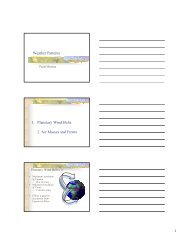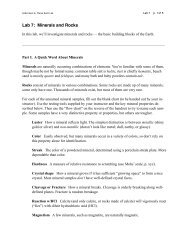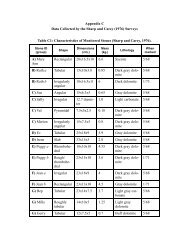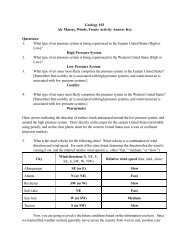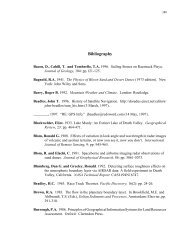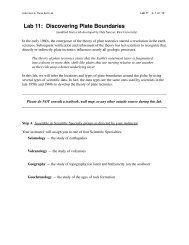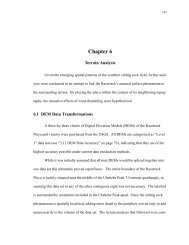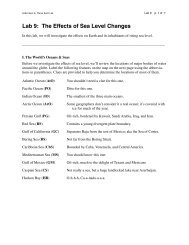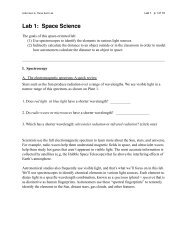baesi - Department of Geology - San Jose State University
baesi - Department of Geology - San Jose State University
baesi - Department of Geology - San Jose State University
You also want an ePaper? Increase the reach of your titles
YUMPU automatically turns print PDFs into web optimized ePapers that Google loves.
SUMMARY REPORT OF THE<br />
BAY AREA EARTH SCIENCE INSTITUTE (BAESI)<br />
FIVE-YEAR SATURDAY WORKSHOPS AND<br />
FIELD TRIPS (2003 – 2008)<br />
PREPARED FOR:<br />
DR. ELLEN METZGER<br />
SAN JOSE STATE UNIVERSITY<br />
Prepared by the:<br />
Center for Educational Planning<br />
<strong>San</strong>ta Clara County Office <strong>of</strong> Education<br />
Revised January 30, 2009
Table <strong>of</strong> Contents<br />
SUMMARY REPORT OF THE BAY AREA EARTH SCIENCE INSTITUTE (BAESI) FIVE-YEAR SATURDAY<br />
WORKSHOPS AND FIELD TRIPS (2003-2008) ....................................................................................................... 1<br />
INTRODUCTION ........................................................................................................................................................ 1<br />
EVALUATION QUESTIONS...................................................................................................................................... 2<br />
EVALUATION RESULTS .......................................................................................................................................... 2<br />
COMPARISON OF EVALUATION RATINGS ACROSS FIVE AND A HALF YEARS ........................................ 3<br />
SUMMARY OF AVERAGE EVALUATION RATINGS BY ACTIVITY AND YEAR ........................................... 4<br />
CONCLUSION............................................................................................................................................................. 6<br />
APPENDIX A: LIST OF SATURDAY WORKSHOPS/FIELD TRIPS AND PARTICIPANTS (2003-2008)........... 7
Summary Report <strong>of</strong> the Bay Area Earth Science Institute (BAESI) Five-<br />
Year Saturday Workshops and Field Trips (2003-2008)<br />
Introduction<br />
The Bay Area Earth Science Institute (BAESI) is a pr<strong>of</strong>essional development<br />
program for teachers <strong>of</strong> students in grades 4-12 that supplies standards-based earth<br />
science concepts and effective strategies for teaching them. This summary report covers<br />
a span <strong>of</strong> five and a half years <strong>of</strong> Saturday workshops and field trips conducted by BAESI<br />
(2003-2008).<br />
BAESI participants are drawn not only from the South Bay close to <strong>San</strong> José, but<br />
also come from the greater <strong>San</strong> Francisco Bay Area, with some teachers traveling<br />
distances <strong>of</strong> about 100 miles to attend. About 80% teach in schools with >25%<br />
enrollment <strong>of</strong> underrepresented groups, and about 60% teach in schools with >50%<br />
enrollment <strong>of</strong> underrepresented groups.<br />
From 2003 to 2008, the BAESI conducted 44 Saturday workshops and field trips;<br />
this report summarizes surveys from 39 <strong>of</strong> these events which included a total <strong>of</strong> 619<br />
responses. Some participants have attended more than one workshop or field trip.<br />
All BAESI workshops are keyed to the Science Content Standards for California<br />
Public Schools, Kindergarten through Grade Twelve and connections to the Standards<br />
are explicitly discussed in the workshops. BAESI workshops aim for an approximately<br />
50-50 blend <strong>of</strong> fundamental earth science concepts and ready-to-use classroom activities.<br />
Participant may earn 1 unit <strong>of</strong> inexpensive (~$40/unit) university credit for participating<br />
in any two full-day Saturday sessions.<br />
The majority <strong>of</strong> workshops and field trips were led by BAESI Co-Directors Ellen<br />
Metzger and Richard Sedlock, both Pr<strong>of</strong>essors in the <strong>Department</strong> <strong>of</strong> <strong>Geology</strong> at <strong>San</strong> José<br />
<strong>State</strong> <strong>University</strong>. Other instructors included Phil St<strong>of</strong>fer (United <strong>State</strong>s Geological<br />
Survey), Joan Carter (a teacher at Branham High School in <strong>San</strong> José who also teaches an<br />
introductory geology course at SJSU), Eugene Cordero (SJSU Meteorology), Michael<br />
Kaufman (SJSU Physics), and Angela Hessler (Chevron).<br />
Workshops were designed for teachers; however a mixture <strong>of</strong> students, teachers,<br />
and volunteers were able to attend certain field trips (see Appendix A). Appendix A lists<br />
the dates and topics <strong>of</strong> the workshops/field trips, the instructor(s), the number <strong>of</strong><br />
participants and the number <strong>of</strong> teachers who completed evaluations. The comprehensive<br />
five-year report (available at http://www.<strong>baesi</strong>.org/Eval09.htm) contains a detailed<br />
summary <strong>of</strong> each evaluation, covering workshops and field trips from 2003 through the<br />
fall <strong>of</strong> 2008.<br />
1
Evaluation Questions<br />
Teachers were asked four evaluation questions about the effectiveness,<br />
usefulness, content, and quality <strong>of</strong> the presentation. Teachers were able to provide<br />
comments or suggestions at the end <strong>of</strong> the evaluation. The four evaluation questions<br />
were: 1) How effective was this workshop in teaching you earth science concepts; 2)<br />
How useful was this workshop in giving you ideas and strategies you can use in your<br />
science classes; 3) How difficult was the academic content <strong>of</strong> this presentation; and<br />
4) How would you rate the workshop leader(s) in terms <strong>of</strong> being prepared, presenting<br />
information clearly and effectively, and responding to questions Teachers rated each<br />
question from a range <strong>of</strong> 1, being the lowest, to 4, being the highest, with the difficulty<br />
level question (Question 3) rated in reverse (1, easy, to 4, very difficult).<br />
Evaluation Results<br />
A total <strong>of</strong> 619 teacher participants completed evaluations during the span <strong>of</strong> 2003<br />
to 2008. Teacher participants were asked to evaluate the effectiveness, usefulness,<br />
difficulty level, and quality <strong>of</strong> the presentation <strong>of</strong> each BAESI Saturday workshop/field<br />
trip. Teachers’ ratings <strong>of</strong> all aspects <strong>of</strong> the workshops and field trips were positive;<br />
average ratings and frequencies for each question were calculated. Frequency <strong>of</strong><br />
responses for each question can be found in the comprehensive five-year report.<br />
Overall, the BAESI has provided quality activities to teachers who found the<br />
workshops and field trips to benefit their pr<strong>of</strong>essional development and teaching <strong>of</strong> earth<br />
science. Average ratings for the presentation quality was 3.8 (“outstanding”), ratings<br />
ranged from 3.3 to 4.0; effectiveness <strong>of</strong> the workshop/field trip in teaching earth science<br />
concepts was 3.7 (“very effective”), ranging from 2.9 to 4.0; difficulty <strong>of</strong> the academic<br />
content <strong>of</strong> the presentation was 2.1 (“about right”), ranging from 1.7 to 2.6; and<br />
usefulness in providing ideas and strategies for use with science classes was 3.6 (“very<br />
useful”), ranging from 2.5 to 4.0. Comparisons <strong>of</strong> the average ratings <strong>of</strong> all workshops<br />
and field trips are presented in the next section <strong>of</strong> this report.<br />
2
Comparison <strong>of</strong> Evaluation Ratings Across Five and a Half Years<br />
The table below compares evaluations by teacher participants in the 2003-2008<br />
Saturday workshops and field trips. A total <strong>of</strong> 619 responses are included in the table<br />
below.<br />
Highest average ratings were given for the quality <strong>of</strong> the preparedness and<br />
presentation <strong>of</strong> field trip and workshop leaders (3.8 out <strong>of</strong> 4.0), which was followed by<br />
the effectiveness <strong>of</strong> the field trip/activity in teaching earth science concepts (3.7), and<br />
usefulness in providing ideas and strategies for use with science classes (3.6).<br />
Participants also gave an average rating <strong>of</strong> about right (2.1) for difficulty level.<br />
Question<br />
1. How effective was this field<br />
trip/activity in teaching you earth<br />
science concepts (1=Not at all<br />
effective, 4=Very effective)<br />
2. How useful was this field<br />
trip/activity in giving you ideas and<br />
strategies you can use in your science<br />
class (1=Not at all useful, 4=Very<br />
useful)<br />
3. How difficult was the academic<br />
content <strong>of</strong> this presentation<br />
(1=Easy, 4=Very Difficult)<br />
4. How would you rate the<br />
trip/workshop leader(s) in terms <strong>of</strong><br />
being prepared, presenting<br />
information clearly and effectively,<br />
and responding to questions (1 =<br />
Poor, 4=Outstanding)<br />
Year 1<br />
(2003)<br />
N = 52<br />
Year 2<br />
(2004)<br />
N = 123<br />
Year 3<br />
(2005)<br />
N = 99<br />
Year 4<br />
(2006)<br />
N = 136<br />
Year 5<br />
(2007)<br />
N = 112<br />
Year 5.5<br />
(2008)<br />
N = 97<br />
Average<br />
Rating<br />
3.6 3.6 3.7 3.7 3.8 3.7 3.7<br />
3.7 3.5 3.7 3.7 3.6 3.5 3.6<br />
2.1 2.2 2.0 2.1 2.2 2.1 2.1<br />
3.9 3.8 3.8 3.9 3.9 3.7 3.8<br />
Total N = 619<br />
In the past five and a half years, the BAESI conducted a total <strong>of</strong> 44 Saturday<br />
workshop activities. The next table presents the average evaluation ratings <strong>of</strong> each<br />
question by activity and year for 39 <strong>of</strong> the 44 workshop activities.<br />
3
Summary <strong>of</strong> Average Evaluation Ratings by Activity and Year<br />
How<br />
effective<br />
was this<br />
field<br />
trip/activity<br />
in teaching<br />
you earth<br />
science<br />
concepts<br />
(1=Not at all<br />
effective,<br />
4=Very<br />
effective)<br />
How useful<br />
was this field<br />
trip/activity in<br />
giving you<br />
ideas and<br />
strategies you<br />
can use in<br />
your science<br />
class (1=Not<br />
at all useful,<br />
4=Very useful)<br />
How difficult<br />
was the<br />
academic<br />
content <strong>of</strong> this<br />
presentation<br />
(1=Easy,<br />
4=Very<br />
Difficult)<br />
How would you rate<br />
the trip/workshop<br />
leader(s) in terms <strong>of</strong><br />
being prepared,<br />
presenting<br />
information clearly<br />
and effectively, and<br />
responding to<br />
questions<br />
(1=Poor,<br />
4=Outstanding)<br />
Year 1 (2003)<br />
#1 Castle Rock <strong>State</strong> Park and<br />
<strong>San</strong>born County Park (N=35) 3.6 3.6 2.1 3.9<br />
#2 Mars (N=17) 3.7 3.9 2.1 3.9<br />
Average Rating (N=52) 3.6 3.7 2.1 3.9<br />
Year 2 (2004)<br />
#1 Weather (N=22) 3.7 3.8 2.1 3.7<br />
#2 Field Trip to Pinnacles<br />
(N=10) 3.0 2.5 2.1 3.6<br />
#3 Plate Tectonics (N=17) 3.8 3.8 2.4 3.9<br />
#4 Field Trip: Moss Beach to<br />
Mussel Rock (N=20) 3.7 3.3 2.4 4.0<br />
#5 Field Trip to the Coast<br />
(N=9) 3.0 3.0 2.2 3.6<br />
#6 Volcanoes and the Earth<br />
System (N=25) 3.7 3.8 2.0 3.8<br />
#7 Effects <strong>of</strong> Earthquakes on<br />
People and the Landscape<br />
(N=20) 4.0 3.9 2.1 4.0<br />
Average Rating (N=123) 3.6 3.5 2.2 3.8<br />
Year 3 (2005)<br />
#1 California’s Water (N=19) 3.8 3.8 1.9 3.8<br />
#2 Field Trip to Hayward Fault<br />
(N=6) 4.0 3.8 1.7 4.0<br />
#3 Field Trip to <strong>San</strong>ta Teresa<br />
Hills (N=17) 3.8 3.8 1.9 4.0<br />
#4 Geologic Hazards (N=18) 3.9 3.8 2.1 3.8<br />
#5 Field Trip to Hayward<br />
Fault/Coyote Hills (N=10) 3.5 3.4 1.7 3.8<br />
#6 Using Authentic Data to<br />
Teach Meteorology (N=12) 3.0 3.3 2.3 3.3<br />
#7 Shaping Earth’s Surface<br />
(N=17) 3.8 3.8 2.3 3.8<br />
Average Rating (N=99) 3.7 3.7 2.0 3.8<br />
4
How<br />
effective<br />
was this<br />
field<br />
trip/activity<br />
in teaching<br />
you earth<br />
science<br />
concepts<br />
(1=Not at all<br />
effective,<br />
4=Very<br />
effective)<br />
How useful<br />
was this field<br />
trip/activity in<br />
giving you<br />
ideas and<br />
strategies you<br />
can use in<br />
your science<br />
class (1=Not<br />
at all useful,<br />
4=Very useful)<br />
How difficult<br />
was the<br />
academic<br />
content <strong>of</strong> this<br />
presentation<br />
(1=Easy,<br />
4=Very<br />
Difficult)<br />
How would you rate<br />
the trip/workshop<br />
leader(s) in terms <strong>of</strong><br />
being prepared,<br />
presenting<br />
information clearly<br />
and effectively, and<br />
responding to<br />
questions<br />
(1=Poor,<br />
4=Outstanding)<br />
Year 4 (2006)<br />
#1 Earthquakes: Faults and<br />
Hazards (N=11) 4.0 3.8 2.6 4.0<br />
#2 Rocks and Minerals (N=23) 3.8 3.4 2.1 3.9<br />
#3 Field Trip to <strong>San</strong>ta Teresa<br />
Hills (N=4) 4.0 3.8 2.0 4.0<br />
#4 Sun-Earth Connections<br />
(N=21) 3.8 3.9 2.3 3.9<br />
#5 Understanding Earth Science<br />
Through Problem-Based<br />
Learning (N=18) 2.9 3.3 1.8 3.4<br />
#6 Field Trip to Alum Rock<br />
Park (N=2) 4.0 4.0 2.0 4.0<br />
#7 Climate Change (N=19) 3.8 3.9 2.0 3.9<br />
#8 Field Trip: Coastal <strong>Geology</strong><br />
(N=17) 3.5 3.3 1.9 3.8<br />
#9 California’s Water (N=21) 3.7 3.8 2.1 3.9<br />
Average Rating (N=136) 3.7 3.7 2.1 3.9<br />
Year 5 (2007)<br />
#1 Dynamic Earth: Plate<br />
Tectonics (N=10) 3.8 3.7 2.3 3.9<br />
#2 Earthquakes and Volcanoes<br />
(N=9) 3.7 3.9 2.0 4.0<br />
#3 Global Warming (N=20) 3.8 3.7 2.1 4.0<br />
#4 and #5 Field Trips to Coyote<br />
Lake-Harvey Bear County Park<br />
(N=14) 3.6 3.5 2.1 3.8<br />
#6 Field Trip to Pinnacles<br />
(N=12) 4.0 3.9 2.0 4.0<br />
#7 <strong>San</strong>ta Cruz (N=15) 3.5 3.3 2.2 3.7<br />
#8 Mt. Diablo (N=16) 3.8 3.4 2.4 3.8<br />
#9 Astronomy (N=16) 3.9 3.6 2.4 4.0<br />
Average Rating (N=112) 3.8 3.6 2.2 3.9<br />
5
Year 5 1/2 (2008)<br />
#1 Models for Teaching Earth<br />
Science (N=15) 3.9 3.9 2.0 3.9<br />
#2 Exploring For Oil and Gas<br />
(N=14) 3.8 3.3 2.2 3.9<br />
#3 Global Warming Food<br />
Connections (N = 23) 3.7 3.7 2.3 3.9<br />
#4 Earth and Life Through<br />
Time (N = 26) 3.6 3.5 1.9 3.4<br />
#5 Energy, Minerals, and the<br />
Future (N = 19) 3.5 3.3 2.1 3.5<br />
Average Rating (N=97) 3.7 3.5 2.1 3.7<br />
Average Rating <strong>of</strong> ALL<br />
BAESI 39 Workshop/Field<br />
Trip Activities<br />
3.7 3.6 2.1 3.8<br />
A total <strong>of</strong> 39 workshops and field trips are summarized in this report (those for<br />
which complete evaluations were compiled and collected). Teachers indicated that the<br />
workshops/field trips were effective in teaching earth science concepts (with a rating <strong>of</strong><br />
3.7 out <strong>of</strong> 4.0). Ratings ranged from 2.9 to 4.0, which showed that teachers found the<br />
workshops to be effective or very effective. Workshops were found on average to be<br />
very useful, providing ideas and strategies that teachers can implement in their science<br />
classes. Some workshops may have been more useful than others; there was a large<br />
variance in ratings for workshop usefulness, ratings ranged from 2.5 to 4.0. The<br />
academic content <strong>of</strong> the workshops were rated to be about right, ranging from 1.7 to 2.6;<br />
teachers found workshops to be between easy and somewhat difficult, but not very<br />
difficult. Workshop and field trip leaders were found to be on average good or<br />
outstanding in their preparedness and presentation. Ratings, for workshop/field trip<br />
leaders, across the different activities ranged from 3.3 to 4.0. Overall, the BAESI has<br />
provided quality activities to teachers who found the workshops and field trips to benefit<br />
their pr<strong>of</strong>essional development and teaching <strong>of</strong> earth science.<br />
Conclusion<br />
The Bay Area Earth Science Institute (BAESI) plans to continue pr<strong>of</strong>essional<br />
development programs for teachers <strong>of</strong> students in grades 4-12. Feedback from the<br />
teacher participants will be used to improve the workshops and field trips and to address<br />
requested workshop topics. The evaluations support the effectiveness and usefulness <strong>of</strong><br />
the Saturday workshops and field trips which were designed to address standards-based<br />
earth science concepts and teaching strategies.<br />
6
Appendix A: List <strong>of</strong> Saturday Workshops/Field Trips and Participants<br />
(2003-2008)<br />
Date Topic Instructor(s)*<br />
Number <strong>of</strong><br />
Participants<br />
# included in<br />
Report<br />
2003<br />
January 23 El Nino JC 19 Missing<br />
July 15 – 17 Maps! Maps! Maps! RS, EM, P. Messina 33 Missing<br />
October 18 Field trip to Castle Rock <strong>State</strong> Park/ PS 51<br />
<strong>San</strong>born County Park<br />
(21 teachers)<br />
35<br />
November 15 Mars! EM 18 17<br />
2004<br />
January 24 Weather EC, JC, Mike Voss 24 22<br />
April 24 The Search for Life on Mars SETI Institute, EM 19 Missing<br />
May 1 Field trip to the Pinnacles RS, EM 29 10<br />
May 15 Plate Tectonics EM 19 17<br />
July 7<br />
Field trip: Moss Beach to Mussel<br />
RS<br />
Unknown 20<br />
Rock<br />
October 9 Field trip to the Coast RS, EM 49<br />
9<br />
(13 teachers)<br />
November 13 Volcanoes and the Earth System EM 27 25<br />
November 20 Effects <strong>of</strong> Earthquakes on People<br />
RS<br />
21 20<br />
and the Landscape<br />
2005<br />
February 12 Asian Tsunami and Earthquake EM 27 Missing<br />
March 5 California’s Water RS 24 19<br />
April 24 Field trip: Hayward Fault RS, EM 75<br />
(5 teachers)<br />
6<br />
April 30 Field trip: <strong>San</strong>ta Teresa Hills RS, EM 23<br />
(16 teachers)<br />
17<br />
September 17 Geologic Hazards EM 19 18<br />
October 15 Field trip: Hayward Fault/Coyote RS, EM 71<br />
Hills<br />
(16 teachers)<br />
10<br />
October 29 Using Authentic Data to Teach<br />
JC<br />
Meteorology<br />
15 12<br />
November 19 Shaping Earth’s Surface RS 19 17<br />
2006<br />
January 14 Earthquakes: Faults and Hazards RS 17 11<br />
February 4 Rocks and Minerals H. Scherer, EM 24 23<br />
February 11 Field Trip to <strong>San</strong>ta Teresa Hills (1/2 RS, EM 34<br />
4<br />
Day)<br />
(4 teachers)<br />
March 4 Sun-Earth Connections EM 22 21<br />
April 22 Understanding Earth Science<br />
JC<br />
19 18<br />
Through Problem-Based Learning<br />
7
Date Topic Instructor(s)*<br />
Number <strong>of</strong><br />
Participants<br />
# included in<br />
Report<br />
2006<br />
continued…<br />
May 2 Field trip to Alum Rock Park EM Unknown Missing<br />
May 20<br />
Field trip to <strong>San</strong> Lorenzo Creek/<br />
PS<br />
Loma Prieta Summit<br />
14 2<br />
September 16 Climate Change EM 20 19<br />
October 7 Field trip: Coastal <strong>Geology</strong> RS, EM 65<br />
(19 teachers)<br />
17<br />
November 18 California’s Water RS 22 21<br />
2007<br />
January 13 Dynamic Earth: Plate Tectonics RS 10 10<br />
January 20 Earthquakes and Volcanoes EM 13 9<br />
March 31 Field trip: Coyote Lake-Harvey Bear PS<br />
Co. Park<br />
18 14<br />
April 1<br />
Field trip: Coyote Lake-Harvey Bear PS<br />
Co. Park<br />
16<br />
April 14 Global Warming EC 20 20<br />
May 19 Field trip to the Pinnacles RS,EM 36<br />
(13 teachers)<br />
12<br />
September 22 Field trip to the <strong>San</strong>ta Cruz Area PS 28 15<br />
October 20 Field trip to Mt. Diablo Northern CA<br />
Geological Society<br />
16 16<br />
October 27 Astronomy MK 20 16<br />
2008<br />
March 15 Models for Teaching Earth Science JC 20 15<br />
same teachers<br />
above<br />
April 5<br />
Exploring for Oil and Gas (Chevron Angela Hessler<br />
in <strong>San</strong> Ramon/Mt. Diablo field trip) (Chevron)<br />
16 14<br />
September 27 Global Warming Food Connections EC, RS 23 23<br />
November 15 Earth and Life Through Time JH, EM, L. Flammer 27 26<br />
December 6 Energy, Minerals, and the Future RS 22 19<br />
Instructor(s)*<br />
EC: Eugene Cordero (SJSU Meteorology)<br />
EM: Ellen Metzger (SJSU <strong>Geology</strong>)<br />
JC: Joan Carter: Branham High School; SJSU <strong>Geology</strong><br />
JH; Jonathan Hendricks (SJSU <strong>Geology</strong>)<br />
MK: Michael Kauffman (SJSU Physics)<br />
PS: Phil St<strong>of</strong>fer (United <strong>State</strong>s Geological Survey)<br />
RS: Richard Sedlock (SJSU <strong>Geology</strong>)<br />
Note: # included in Report = Teacher Participants.<br />
Field trips are in rows shaded in light blue.<br />
5-year Total: 27 Workshop Activities and 17 Field Trips<br />
5-year Total Included in this Report: 23 Workshop Activities and 16 Field Trips (N=39)<br />
8




